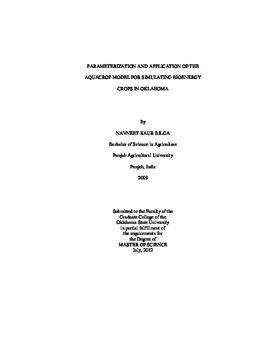| dc.contributor.advisor | Ochsner, Tyson E. | |
| dc.contributor.author | Bilga, Navneet Kaur | |
| dc.date.accessioned | 2014-04-15T22:05:52Z | |
| dc.date.available | 2014-04-15T22:05:52Z | |
| dc.date.issued | 2012-07-01 | |
| dc.identifier.uri | https://hdl.handle.net/11244/9304 | |
| dc.description.abstract | The objective of this study was to parameterize the AquaCrop model for two bioenergy crops, switchgrass and forage sorghum, using field measurements from Stillwater, Oklahoma in 2011. The parameterized model was then validated for additional sites at Chickasha and Woodward, Oklahoma. After parameterization at Stillwater, the simulated canopy cover closely matched the measured canopy cover dynamics with a RMSE of 6% in switchgrass and 5% in forage sorghum. The water stress thresholds for canopy expansion and stomatal conductance were similar for switchgrass and forage sorghum, but senescence was induced at 35% available water depletion for forage sorghum compared to 85% for switchgrass. The maximum rooting depth of switchgrass was estimated at 190 cm and that of forage sorghum at 120 cm. The normalized water productivity of switchgrass was found to be 14 g m-2, approximately half that of forage sorghum which was 27 g m-2. The parameterized model reasonably simulated soil water depletion at Stillwater (RMSE < 34 mm) and canopy cover at Chickasha and Woodward (RMSE < 11%) for both crops. This calibrated model was then used to predict ethanol yields as a simulation study at Goodwell, Oklahoma. The corn, forage sorghum and switchgrass were simulated using AquaCrop five water levels: rainfed with initial soil moisture conditions of 60% available water capacity, 80% available water capacity, 100% available water capacity, and irrigation treatments at 70% allowable depletion, and at 50% allowable depletion. The simulation study was done over a period of ten years 2002-2011 to assess the long term performance. County average yields were consistent with simulated grain yields for corn under irrigated and rainfed conditions. Forage sorghum produced 30 % higher theoretical ethanol yields than corn under irrigated environments but not under rainfed environments. Switchgrass did not produce significantly higher theoretical ethanol yields than corn at any water level. Based on this modeling study, forage sorghum may have potential as an alternative to corn in the Oklahoma Panhandle given the advent of cellulosic ethanol production but forage sorghum is unlikely to help meet the challenge of groundwater depletion. | |
| dc.format | application/pdf | |
| dc.language | en_US | |
| dc.publisher | Oklahoma State University | |
| dc.rights | Copyright is held by the author who has granted the Oklahoma State University Library the non-exclusive right to share this material in its institutional repository. Contact Digital Library Services at lib-dls@okstate.edu or 405-744-9161 for the permission policy on the use, reproduction or distribution of this material. | |
| dc.title | Parameterization and Application of the Aquacrop Model for Simulating Bioenergy Crops in Oklahoma | |
| dc.type | text | |
| dc.contributor.committeeMember | Kakani, Vijaya Gopal | |
| dc.contributor.committeeMember | Zou, Chris | |
| osu.filename | Bilga_okstate_0664M_12175.pdf | |
| osu.college | Agricultural Sciences and Natural Resources | |
| osu.accesstype | Open Access | |
| dc.description.department | Department of Plant and Soil Sciences | |
| dc.type.genre | Thesis | |
| dc.subject.keywords | aquacrop | |
| dc.subject.keywords | bioenergy | |
| dc.subject.keywords | ethanol | |
| dc.subject.keywords | forage sorghum | |
| dc.subject.keywords | oklahoma | |
| dc.subject.keywords | switchgrass | |
